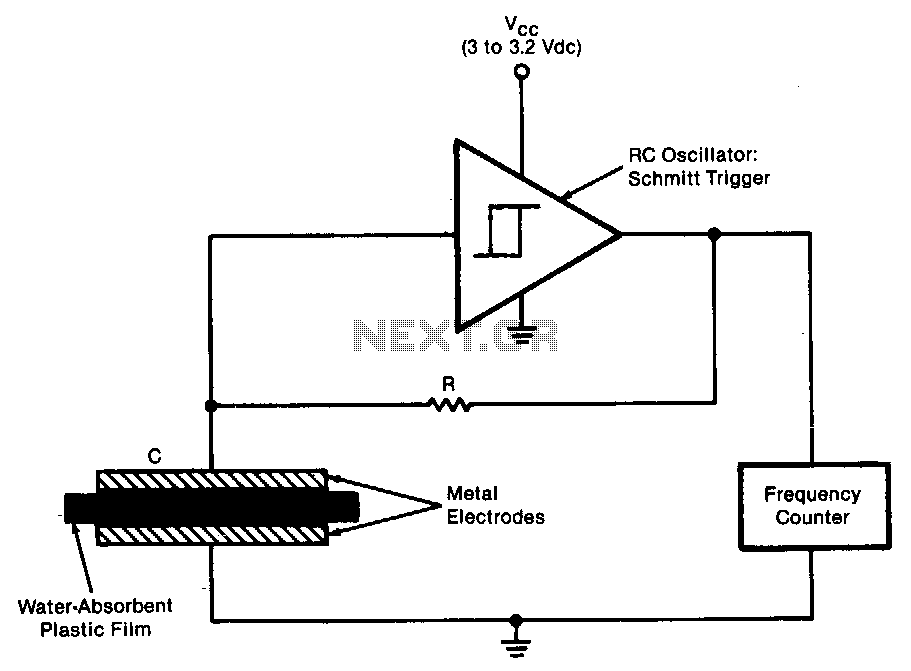
Low-cost-humidity-sensor

The sensor operates as an RC oscillator, utilizing a water-absorbent plastic film as the insulator within the capacitive element. The capacitance of this film increases with the amount of water it absorbs from the air, resulting in a reduction of the oscillation frequency. A frequency counter generates a digital output that indicates the change in frequency, which corresponds to the variation in relative humidity. This sensor is applicable for measuring humidity in various environments, including the atmosphere, soil, and industrial gases. Additionally, a Schmitt-trigger-type integrated circuit (IC) is connected to the capacitor, which consists of a commercially produced sulfonated fluorocarbon polymer film measuring 2 inches (5.08 cm) square, sandwiched between perforated metal plates. The oscillation frequency decreases almost linearly from approximately 100 kHz to 16 kHz as the relative humidity rises from about 20% to 76%.
The described humidity sensor employs an RC oscillator configuration, where the key component is a capacitive element formed by a water-absorbent plastic film. This film acts as the dielectric material, and its capacitance varies with the moisture content in the environment. The principle of operation relies on the correlation between the absorbed water and the dielectric constant of the film, which directly influences the oscillation frequency of the circuit.
In this design, when the relative humidity increases, the water absorption leads to a higher capacitance, which in turn lowers the frequency of oscillation. The frequency counter connected to the oscillator detects this change in frequency and converts it into a digital signal, providing a quantifiable measurement of relative humidity. This digital output can be interfaced with microcontrollers or other digital systems for further processing or display.
The inclusion of a Schmitt-trigger IC enhances the stability and reliability of the output signal by providing hysteresis, which helps in minimizing false triggering due to noise or fluctuations in the oscillation frequency. The specific choice of a sulfonated fluorocarbon polymer film as the capacitive element is advantageous due to its predictable response to humidity changes and durability in various environmental conditions.
The linear relationship between the oscillation frequency and relative humidity allows for straightforward calibration and accurate readings across a specified range. The sensor's performance, with a frequency shift from about 100 kHz at low humidity to 16 kHz at high humidity, demonstrates its effectiveness in diverse applications, including meteorological measurements, agricultural monitoring, and industrial process control, where precise humidity levels are critical.The sensor is an RC oscillator in which, a water-absorbent plastic film is the insulator in the capacitive element. The capacitance of the film increases with the amount of water it absorbs from the air, and thus reduces the oscillation frequency.
A frequency counter produces a digital output that represents the change inirequency and hence the change in relative humidity. The sensor can be used to measure humidity in the atmosphere, in the soil, and in industrial gases, for example.
A Schmitt-trigger-type IC is connected to the capacitor, which consists of a film of a commercially produced sulfonated fluorocarbon polymer, 2 in. (5.08 em) square, sandwiched between perforated metal plates. The oscillation frequency decreases almost linearly from about 100 to 16 kHz as the relative humidity increases from about 20 to 76%.
🔗 External reference
The described humidity sensor employs an RC oscillator configuration, where the key component is a capacitive element formed by a water-absorbent plastic film. This film acts as the dielectric material, and its capacitance varies with the moisture content in the environment. The principle of operation relies on the correlation between the absorbed water and the dielectric constant of the film, which directly influences the oscillation frequency of the circuit.
In this design, when the relative humidity increases, the water absorption leads to a higher capacitance, which in turn lowers the frequency of oscillation. The frequency counter connected to the oscillator detects this change in frequency and converts it into a digital signal, providing a quantifiable measurement of relative humidity. This digital output can be interfaced with microcontrollers or other digital systems for further processing or display.
The inclusion of a Schmitt-trigger IC enhances the stability and reliability of the output signal by providing hysteresis, which helps in minimizing false triggering due to noise or fluctuations in the oscillation frequency. The specific choice of a sulfonated fluorocarbon polymer film as the capacitive element is advantageous due to its predictable response to humidity changes and durability in various environmental conditions.
The linear relationship between the oscillation frequency and relative humidity allows for straightforward calibration and accurate readings across a specified range. The sensor's performance, with a frequency shift from about 100 kHz at low humidity to 16 kHz at high humidity, demonstrates its effectiveness in diverse applications, including meteorological measurements, agricultural monitoring, and industrial process control, where precise humidity levels are critical.The sensor is an RC oscillator in which, a water-absorbent plastic film is the insulator in the capacitive element. The capacitance of the film increases with the amount of water it absorbs from the air, and thus reduces the oscillation frequency.
A frequency counter produces a digital output that represents the change inirequency and hence the change in relative humidity. The sensor can be used to measure humidity in the atmosphere, in the soil, and in industrial gases, for example.
A Schmitt-trigger-type IC is connected to the capacitor, which consists of a film of a commercially produced sulfonated fluorocarbon polymer, 2 in. (5.08 em) square, sandwiched between perforated metal plates. The oscillation frequency decreases almost linearly from about 100 to 16 kHz as the relative humidity increases from about 20 to 76%.
🔗 External reference